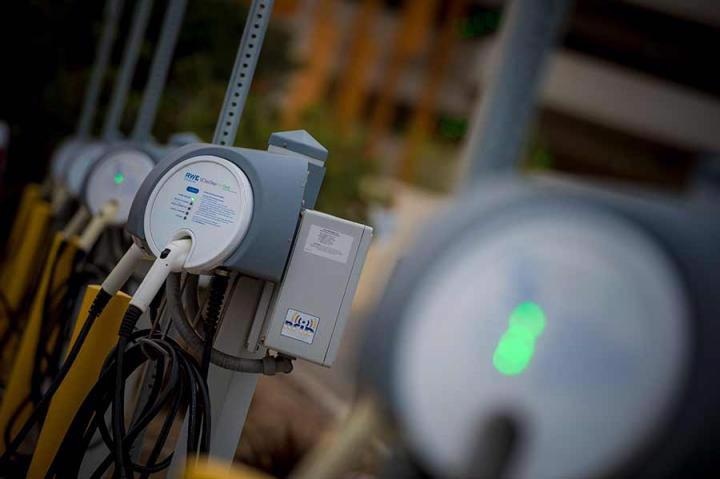May 7 2021
A group of engineers proposed an increase in the number of fast-charging stations for electric vehicles as businesses and campuses begin their plans for a post-pandemic world.
 The University of California San Diego is home to one of the largest, most diverse range of electric vehicle charging stations at any university in the world. Image Credit: University of California San Diego.
The University of California San Diego is home to one of the largest, most diverse range of electric vehicle charging stations at any university in the world. Image Credit: University of California San Diego.
The suggestion depends on a study of charging patterns for electric vehicles on the University of California San Diego campus between early January and late May of 2020 after the university decided to shift a majority of its operations online. According to the engineers, the findings could be employed in a wider range of settings.
Workplace charging is a critical enabler of carbon-free transportation as the electrons consumed primarily come from solar power plants, as opposed to at-home charging, which occurs at night and relies more on fossil fuel power plants.
Jan Kleissl, Study Senior Author and Professor of Environmental Engineering, University of California San Diego
It is the very first time that a group of researchers has collected the details on workplace charging patterns for electric vehicles at the time of the COVID-19 pandemic. As predicted, charging dropped considerably as soon as most campus operations turned out to be remote.
Moreover, as anticipated, charging at the medical center on the campus was less affected as medical facilities retained most in-person operations and healthcare workers as well as patients kept utilizing those charging stations.
This reflects trends across the country. Vehicle travel in the United States dropped by around 40% from mid-March to mid-April 2020, as per the statistics received from the National Bureau of Economic Research.
However, DC fast chargers that offer a complete charge in around half an hour were less impacted compared to the so-called Level 2 chargers, which offer a complete charge for more than eight hours. Energy sent at Level 2 chargers on the main UC San Diego campus reduced by 84%. In the beginning, DC fast charging went down by 67%. Such stations rapidly came back to near-normal usage in a short while, unlike Level 2 charging stations.
This finding reinforces ongoing efforts to deploy at least an additional 20 DCFCs primarily on the perimeter of campus in order to serve both UC San Diego commuters as well as the general public in need of recharging.
Byron Washom, Study Co-Author, Director of Strategic Energy Initiatives, University of California-San Diego
The researchers describe their results in the March 23rd issue of the Journal of Renewable and Sustainable Energy.
In the study, among 100 stations, only four were fast-charging. More extensively, in the United States, only a small fraction of charging stations is fast-charging, and a majority of those only serve Tesla vehicles.
For instance, California holds around 31,800 EV charging stations. Among them, nearly 3000 are Tesla supercharging stations that are only available to Tesla vehicles. An extra 470 are DCFC stations that are regulated by California-based Chargepoint.
The researchers analyzed 100 charging stations in 28 parking structures. Particularly, they identified that between March 11 and May 20, 2020:
- Charging on the main campus went down by 84% from pre-pandemic levels
- At the UC San Diego medical center locations, charging fell by 50% at the parking structures
- At first, charging at DC fast-charging stations went down by 67% before going back up close to pre-pandemic levels
According to the researchers, charging will probably not return to normal even after the pandemic comes to an end.
Commuting patterns based on five days a week in the office are unlikely to resume, however, as employers may allow more telecommuting even after the end of the pandemic.
Jan Kleissl, Study Senior Author and Professor of Environmental Engineering, University of California San Diego
That might be good news as the expected drastic increase in EV adoption over the following years would otherwise strain the present charging infrastructure, added Kleissl.
Journal Reference:
McClone, G., et al. (2021) Impact of the coronavirus pandemic on electric vehicle workplace charging. Journal of Renewable and Sustainable Energy. doi.org/10.1063/5.0038641.